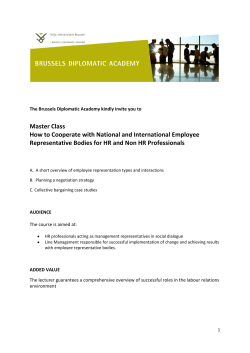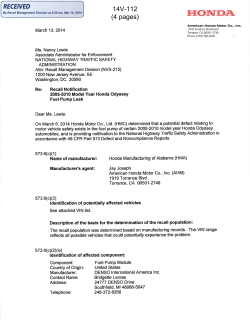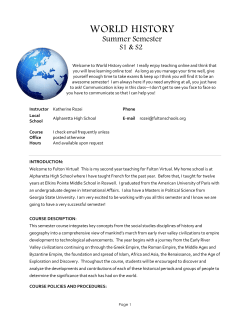
How to Comply with Changes to the Clery Act S. Daniel Carter
How to Comply with Changes to the Clery Act S. Daniel Carter Director of Public Policy y Security On Campus, Inc. About Everbridge • Leader in incident notification systems • Everbridge serves over 100 colleges and universities, ni ersities incl including ding high profile institutions like Virginia Tech, protecting more than 2 million students in emergencies • Fast-growing global company with more than 1,000 clients in more than 100 countries • Serve the Global 2000, healthcare systems, state and local government, federal government, military, financial services firms firms, and universities • 100% focused on incident notification solutions that merge technology and expertise 2 Agenda Part 1: Presentation • What you need to have in place and when • Developing Clery Act compliant protocols • Addressingg annual testingg requirements q • Reporting changes Part 2: Q&A 3 Q&A Note: slides are currently available to everyone on blog.everbridge.com Use the Q&A function to submit your questions. questions 4 How to Comply p y with Changes g to the Clery Act S. Daniel Carter Director of Public Policy S Security it On O Campus, C IInc. Jeanne Ann Clery’s legacy • Raped and murdered on April p 5,, 1986 in her residence hall by a fellow student she didn’t know • History of violent crime on campus • Led to national awareness of campus crime • Federal Clery Act Security On Campus, Inc. • Non-profit established by Connie and Howard Clery in 1987 • Advocacy • Safer campuses/crime prevention • Victims’ rights • Education • Peer-ed • Clery Act training New for 2010 • Emergency response and evacuation • Immediate emergency notification • Responsibilities clearly outlined • Annual test/publicizing p g • New hate crimes • Larceny-theft • Simple assault • Intimidation • Destruction/damage/vandalism New for 2010 • Campuses with housing • Missing students • Campus fire safety • Local/state law enforcement • Agreements for investigating crimes • Memorandum of understanding Emergency response • Beginning 2010, annual security reports must include • Emergency E response and d evacuation ti policy li summary • • • Immediate notification Annual test Annual publicizing of procedures Immediate notification • Immediate threat (all hazards) • To health or safety • Students or employees • On campus Notification process • How/who will confirm emergency/danger? • Determine appropriate segment(s) • Determine the content • Initiate the notification system • Li t off title(s) List titl ( ) responsible ibl Timely warning too? • Emergency notification supersedes timely warning gp process • Notification may contain less information than warning typically would (i.e. (i e crime prevention tips) • Must provide “adequate follow-up information” • All clear • Recovery information Without delay • Must state in policy • Notification will be issued “without delay” • Upon confirmation of emergency • “Taking into account the safety of the community” Exceptions • Compromise efforts • To assist a victim • Contain • Respond to • Otherwise mitigate • P f Professional i l jjudgment d t off responsible ibl authorities th iti Annual test • • • At least once per calendar year • Documenting • Description of the exercise • Date/time • Whether announced Announced or unannounced Publicizing, beyond ASR, in conjunction with annual test or unannounced What is a test? • Regularly scheduled drills, exercises, and appropriate g activities,, designed g for assessment and follow-through evaluation of emergency plans and capabilities. Drill • A drill is a coordinated, supervised exercise activity, normally used to test a single specific operation or function. • With a drill, there is no attempt to coordinate organizations. THIS IS NOT A TEST Tabletop • A tabletop exercise is a facilitated analysis g y situation in an informal,, of an emergency stress-free environment. • It is designed to elicit constructive discussion as participants examine and resolve problems g operational p p plans and based on existing identify where those plans need to be refined. Functional exercise • A functional exercise is a fully simulated interactive exercise that tests the capability p y of an organization g to respond to a simulated event. • The exercise tests multiple functions of the organization’s operational plan. • It is a coordinated response to a situation in a time-pressured, realistic simulation. Full-scale exercise • A full-scale exercise simulates a real event as closely as poss possible. b e Itt is sa an e exercise e c se des designed g ed to e evaluate a uate tthe e operational capability of emergency management systems in a highly stressful environment that simulates actual response conditions conditions. • To accomplish this realism, it requires the mobilization and d actual t l movementt off emergency personnel, l equipment, and resources. • Ideally, the full-scale f exercise should test and evaluate most functions of the emergency g p plan or operational p p plan. management New hate crimes Types of theft • • • • • • • • Pocket-picking P Purse-snatching t hi Shoplifting Theft from building Theft from coin operated machine or device Theft from motor vehicle Theft of motor vehicle parts or accessories All other larceny New hate crimes New hate crimes New hate crimes Clery Act handbook • Originally published 2005 • Update is being developed • SOC is i h helping l i • What are your ? • Due late 2010/early 2011 Incident Notification for Higher g e Education ducat o Marc Ladin VP of Marketing Everbridge 28 Incident notification solutions address common higher education communication challenges • Communicate quickly, easily, and efficiently with large numbers of people in minutes, not hours, making sure that campus safety issues are communicated quickly • Use all contact paths to reach everyone, using the most popular methods no matter where they may methods, be, on or off-campus • Ensure two-way two way communications to know who may need immediate assistance • Free key personnel to perform critical tasks or staff incident response teams by automating manual, time-intensive, error-prone p processes p • Satisfy regulatory requirements for the Clery Act and U.S. D Department t t off Education’s Ed ti ’ Hi Higher h Education Opportunity Act of 2008 (HEOA) with extensive and complete p g of delivery y attempts p and reporting two-way acknowledgements from recipients 29 The Everbridge difference technology + expertise = empowerment technology + expertise = confidence technology + expertise = solution technology + expertise = your success Everbridge, the world’s recognized leader in incident notification systems, merges technology with industry expertise to help millions of people communicate in a crisis crisis, manage operational incidents, and connect on a daily basis. 30 Key evaluation criteria for an incident notification system • Experience and expertise • Ease of use • Ability to reach all contact paths, including voice voice, email email, native SMS (over SMPP and SMTP), IM, and more • Ease of integration 31 Q&A Note: slides are currently available to everyone on blog.everbridge.com Use the Q&A function to submit your questions. questions 32 Missed anything? Never fear, the recording and slides from today’s today s webinar are just a click away. blog.everbridge.com Reminder Everbridge Insights webinars qualify for Continuing Education Activity Points (CEAPs) for DRI certifications. Visit www.drii.org to register i your credit. di Item Number (Schedule II): 26.1 Activity Group: A 1 Point for each webinar 33 Contact information Communication resources Everbridge Aware for Higher Education everbridge.com/education S. Daniel Carter sdcarter@securityoncampus.org 1-202-684-6471 Marc Ladin marc.ladin@everbridge.com 1 818 230 9700 1-818-230-9700 White papers, papers case studies studies, literature everbridge.com/resources Upcoming webinars everbridge.com/webinars blog.everbridge.com twitter.com/everbridge f facebook.com/everbridgeinc b k / b id i 34
© Copyright 2025















